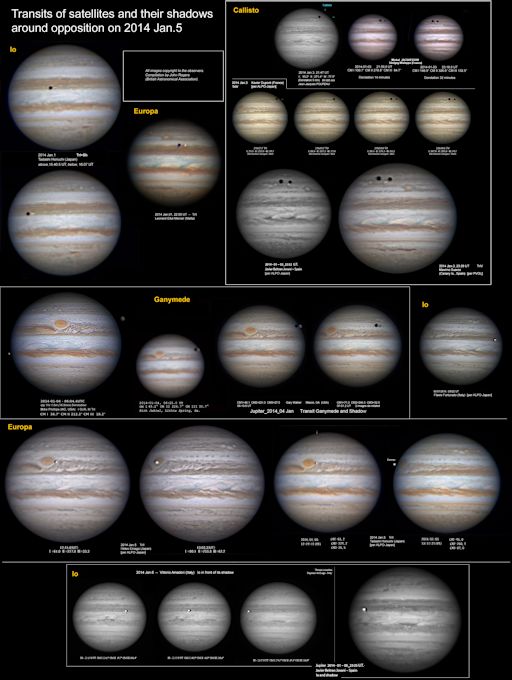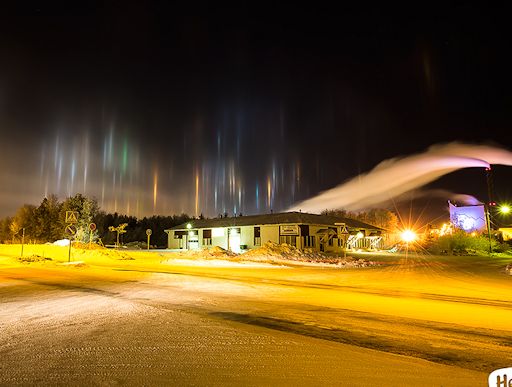Listen to radar echoes from satellites and meteors, live on listener-supported Space Weather Radio. | | | SOLAR SECTOR BOUNDARY CROSSING: High-latitude auroras are possible on Jan. 21st when Earth crosses through a fold in the heliospheric current sheet. This is called a "solar sector boundary crossing," and NOAA forecasters estimate a 25% chance of polar geomagnetic storms when it occurs. Aurora alerts: text, voice. FASCINATING PHENOMENA OF JUPITER'S MOONS: On Jan. 5th, Earth passed directly between the sun and Jupiter. Astronomers call this an "opposition" because the sun and Jupiter were on opposite sides of the sky. "Jupiter's opposition is always an opportunity for beautiful pictures of moons transiting Jupiter, sometimes directly in front of their own shadows," says John H. Rogers, Jupiter Section Director of the British Astronomical Association. "Observers have produced some fine examples from the opposition earlier this month." Some of the best are collected here: 
Transits around opposition are beautiful, but something even more rare and special is coming this fall. "In autumn, Jupiter's moons will begin a series of mutual eclipses and occultations," Rogers says. The satellites will criss-cross in the sky, dipping in and out of one another's shadows. Predictions by Jean Meeus have been posted by the British Astronomical Association Computing Section at these URLs. "The last time these mutual events occurred, in 2009, observers were able to produce the first high-resolution movies of moons eclipsing moons. No doubt some of you will be able to do even better this time around." Stay tuned! Realtime Space Weather Photo Gallery FALSE AURORAS: Lately, in communities around the Arctic Circle, people have been seeing colorful lights in the sky. Although they look like auroras, they are not. Alexander Kuznetsov photographed this apparition over Rovaniemi in the Finnish Lapland on Jan. 17th: 
They're light pillars, caused by ice crystals in the air which intercept urban lights and spread them into colorful columns. No solar activity is required for the phenomenon. The only ingredients are ice and light pollution. "The temperature was -27°C – perfect weather for these to occur," says Kuznetsov. "I have seen light pillars before, but never so many." Although the pillars were clearly visible to the unaided eye, he decided to use a 20 second exposure to create a dramatic trail of smoke from the foreground chimneys. The long exposure accentuated slight differences in the hue of city lights, creating a truly polychromatic image. More examples may be found in the realtime photo gallery:
Realtime Space Weather Photo Gallery
Realtime Aurora Photo Gallery
Realtime Venus Photo Gallery
Realtime Comet Photo Gallery
Every night, a network of NASA all-sky cameras scans the skies above the United States for meteoritic fireballs. Automated software maintained by NASA's Meteoroid Environment Office calculates their orbits, velocity, penetration depth in Earth's atmosphere and many other characteristics. Daily results are presented here on Spaceweather.com. On Jan. 20, 2014, the network reported 13 fireballs.
(13 sporadics) 
In this diagram of the inner solar system, all of the fireball orbits intersect at a single point--Earth. The orbits are color-coded by velocity, from slow (red) to fast (blue). [Larger image] [movies] On Jan. 19, 2014, the network reported 4 fireballs.
(4 sporadics) 
In this diagram of the inner solar system, all of the fireball orbits intersect at a single point--Earth. The orbits are color-coded by velocity, from slow (red) to fast (blue). [Larger image] [movies] Potentially Hazardous Asteroids ( PHAs) are space rocks larger than approximately 100m that can come closer to Earth than 0.05 AU. None of the known PHAs is on a collision course with our planet, although astronomers are finding new ones all the time. On January 20, 2014 there were 1451 potentially hazardous asteroids. Notes: LD means "Lunar Distance." 1 LD = 384,401 km, the distance between Earth and the Moon. 1 LD also equals 0.00256 AU. MAG is the visual magnitude of the asteroid on the date of closest approach. | | The official U.S. government space weather bureau | | | The first place to look for information about sundogs, pillars, rainbows and related phenomena. | | | Researchers call it a "Hubble for the sun." SDO is the most advanced solar observatory ever. | | | 3D views of the sun from NASA's Solar and Terrestrial Relations Observatory | | | Realtime and archival images of the Sun from SOHO. | | | from the NOAA Space Environment Center | | | the underlying science of space weather | | 
